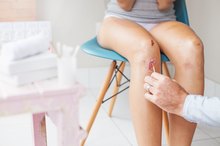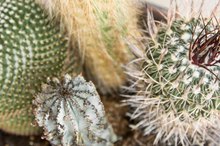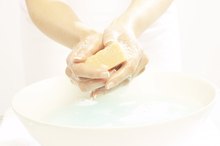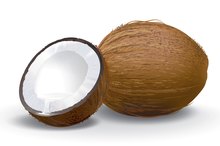Home Remedy to Draw Out Infection
Various bacteria normally populate the surface of your skin. Minor skin trauma -- like getting stuck by a thorn or a pin -- can provide a route of entry, allowing these bacteria to invade and cause a localized infection known as a skin abscess, also commonly called a boil. A boil that arises in a hair follicle is called a furuncle. A boil is a walled-off collection of bacteria and pus that characteristically causes a painful, red, lump beneath the skin surface. You can sometimes treat a small skin abscess yourself using home remedies to bring the pimple-like lump to a head so the infection and pus drains out, allowing the area to heal.
If you are experiencing serious medical symptoms, seek emergency treatment immediately.
Warm Compresses
Application of warm, moist compresses is the easiest and most widely used home remedy to assist in drawing out the infection from a skin abscess or boil 1. You can simply wet a wash cloth with warm tap water, about the temperature of bath water. Lightly wring out the cloth and place it on the affected area for about 20 minutes at least 3 or 4 times daily. Rewet the cloth if it cools too quickly. After each application, place the used cloth in the laundry.
Some people advocate using warm compresses made with water that has been infused with herbs. However, it's unclear whether the addition of herbs to the water improves the effectiveness of the compress to bring the abscess to a head.
You can also use a small hot water bottle, a homemade rice sock or a commercial compress that you heat in the microwave. Keep in mind, however, that you must be able to clean the surface or cloth covering to prevent potential spread of the infection to other parts of your skin or to other people.
- Application of warm, moist compresses is the easiest and most widely used home remedy to assist in drawing out the infection from a skin abscess or boil 1.
- However, it's unclear whether the addition of herbs to the water improves the effectiveness of the compress to bring the abscess to a head.
Poultices
Boils & Pain Relief
Learn More
A poultice is a moist paste usually made from ground herbs or foods mixed with water, oil or another liquid. A wide variety of poultices have been used historically as home remedies for boils and other skin infections 1. These pastes are usually applied to the affected area and covered. When the paste dries, it is removed and moist poultice is reapplied.
Unfortunately, no scientific research has been conducted to determine whether poultices actually help draw out infection from a skin abscess. A few examples of the many poultices that are purported to aid with boils include:
- Heated milk, bread and salt (which acts largely like a warm compress)
- Grated raw potato
- Ground plantain leaves
- Onion-based poultices
- Ground neem leaves (or application of neem oil to the boil)
- A poultice is a moist paste usually made from ground herbs or foods mixed with water, oil or another liquid.
- A few examples of the many poultices that are purported to aid with boils include: * Heated milk, bread and salt (which acts largely like a warm compress)
* Grated raw potato * Ground plantain leaves * Onion-based poultices * Ground neem leaves (or application of neem oil to the boil)
Warnings and Precautions
Most small skin abscesses or boils resolve on their own within 1 to 3 weeks, with or without use of home remedies. However, some skin abscesses do not go away on their own and require medical treatment 7. If you suspect you have a skin abscess/boil and it is large, painful, or has not improved within 2 weeks, see your doctor for treatment.
While it's tempting to squeeze a skin abscess or boil in an attempt to force the infection to drain, you should not squeeze or puncture the area. This can cause the infection to spread deeper into the skin and potentially into your bloodstream.
If you have diabetes or a weakened immune system and suspect you have a skin abscess or boil, contact your doctor without delay and do not attempt home treatment.
When you have a skin abscess or boil, keep it covered with an adhesive bandage or wrap the area in gauze. This will protect the area and contain any infectious drainage oozing from the area.
Skin abscesses and boils can lead to more serious complications. Contact your doctor right away if you experience any warning signs or symptoms including:
- Fever
- Spreading redness around the affected area
- Red streaks radiating from the affected area
- Severe or rapidly worsening pain
Reviewed and revised by: Tina M. St. John, M.D.
- Most small skin abscesses or boils resolve on their own within 1 to 3 weeks, with or without use of home remedies.
- If you suspect you have a skin abscess/boil and it is large, painful, or has not improved within 2 weeks, see your doctor for treatment.
Related Articles
References
- IDSA: Practice Guidelines for the Diagnosis and Management of Skin and Soft Tissue Infections: 2014 Update by the Infectious Diseases Society of America
- Merck Manual Professional Version: Furuncles and Carbuncles
- Clinical Dermatology, 6th Edition; Thomas P. Habif
- VisualDx: Essential Adult Dermatology; Noah Craft, et al.
- Greenberg's Text-Atlas of Emergency Medicine; Michael I. Greenberg
- Advances in Dermatology and Allergology:Medicinal Plants Used in Treatment of Inflammatory Skin Diseases
- Encyclopedia of Folk Medicine: Old World and New World Traditions; Gabrielle Hatfield
- Fundamentals of Herbal Medicine: History, Phytopharmacology and Phytotherapeutics; Kofi Busia
- Merck Manual Professional Version: Cutaneous Abscess
- Kolar SL, Liu GY. Targeting bacterial abscess formation. EBioMedicine. 2016;12:16-17. doi:10.1016/j.ebiom.2016.10.017
- InformedHealth.org [Internet]. Cologne, Germany: Institute for Quality and Efficiency in Health Care (IQWiG); 2006-. Boils and carbuncles: Overview. 2018 Jun 14.
- Creech CB, Al-zubeidi DN, Fritz SA. Prevention of recurrent staphylococcal skin infections. Infect Dis Clin North Am. 2015;29(3):429-64. doi:10.1016/j.idc.2015.05.007
- Patterson, JW. Practical Skin Pathology: A Diagnostic Approach. Amsterdam: Elsevier Health Sciences; 2013.
- Toomey A, Le JK. Abscess, breast. [Updated 2019 Jan 11]. In: StatPearls [Internet]. Treasure Island (FL): StatPearls Publishing; 2019 Jan-.
- National Health Service. Treatment abscess. Update November 4, 2019.
- Baiu I, Melendez E. Skin abscess. JAMA. 2018;319(13):1405. doi:10.1001/jama.2018.1355
- Murren Boezem, J. KidsHealth from Nemours. Abscess. Update September 2017.
- Wolf, K; Johnson, R.; and Suurman, R.. "Section 22. Bacterial infections involving the skin." Fitzpatrick's Color Atlas & Synopsis of Clinical Dermatology (5th ed.). 2005; McGraw-Hill Professional; ISBN-13 978-0071440196.
Writer Bio
Dr. Shavon Jackson-Michel is an expert in the field of health and wellness and has been writing for LIVESTRONG.COM since 2009. She is a university-level professor and a licensed naturopathic physician providing individualized consultations on natural and holistic approaches to chronic disease at her Bloomfield, NJ office. Dr. Jackson-Michel is a doctoral graduate of the University of Bridgeport College of Naturopathic Medicine.









